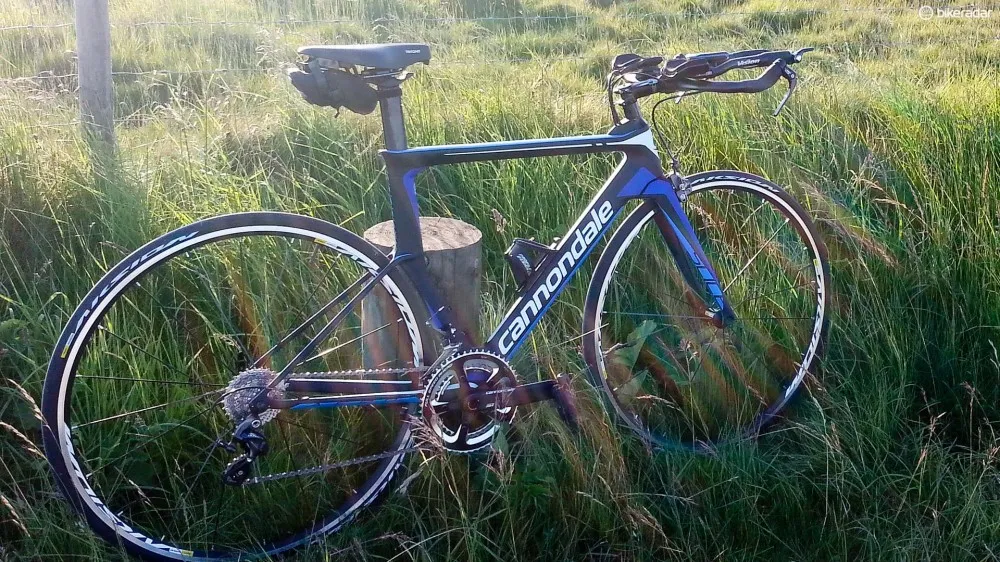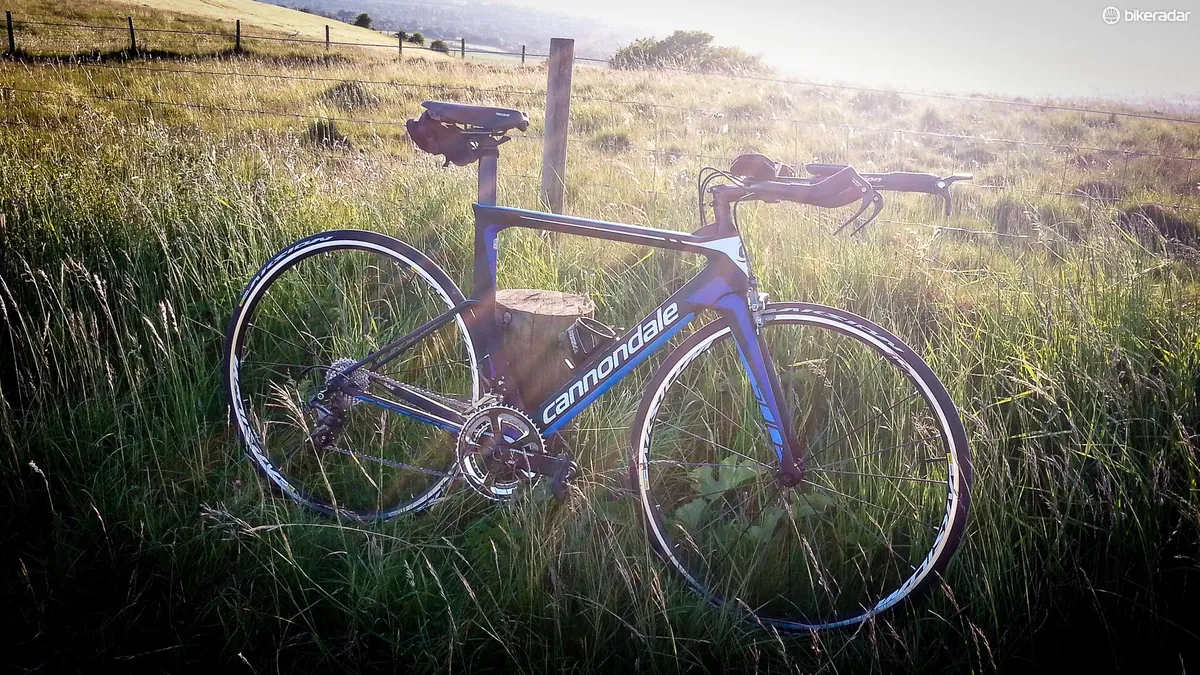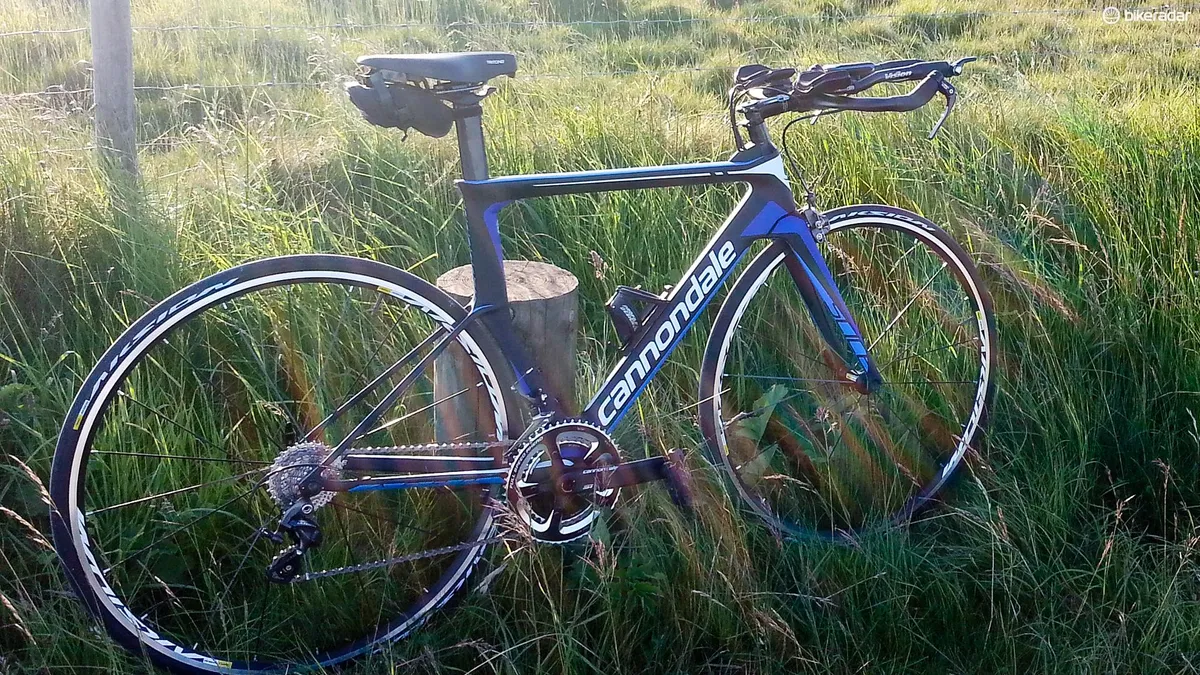The Cannondale Slice has been billed as a lightweight, practical TT bike that aims to prove those three terms aren't mutually exclusive. But can it live up to that promise on its very first ride?
There's nothing quite as nice as a test bike inciting a sense of genuine excitement before mounting up for its initial outing, but that's exactly the feeling stirred by the Slice. The combination of light weight and proper braking along with aero pedigree was, perhaps rather tragically, something I was very much looking forward to.
Just lifting the Slice gave a good first impression. The 8.21kg of this mechanical Ultegra specced model is considerably lighter than any other TT bike I've come across at this price, and is only challenged by top-end superbikes like the Canyon Speedmax and the Slice's own costlier siblings. The frame weight of this lower modulus version is a claimed 1.2kg – that's the same as Felt's £13,000 IA FRD.
Related: Cannondale Slice - just in
Prior to clipping in, I transferred my current setup to the new bike, ahead of an upcoming bike fit. This gave a good idea of how tweaks to the bike’s geometry, informed by work with fit partner Guru, have affected setup adjustability.
The last fit I had put a noseless saddle like the Slice's Tritone 52mm behind the centre of the BB. This usually means generous forward sliding of the saddle rails. On the Slice, I had to move the saddle mount into the rear housing on the seatpost to accommodate this and get the saddle rails back a long way. That is to say that if you use an aggressively forward saddle position, you'll have no problem finding it on the Slice.
Fixing the saddle itself is a little tricky. The seatpost's central bolt has a tiny slotted section for a miniature spanner (couldn’t get an adjustable wrench in there). It's a bit of a faff, but nothing to worry about once set.
One issue that I'd already spotted during the first look stages was the lack of extension length adjustment. The carbon clip-ons were probably chosen for their light weight, but setting the length correctly will mean slackening off the cables, unwrapping the tape, removing the shifters and cutting the extensions down. That permanent fix is another good reason to get a bike fit before modifying anything, especially for those new to TT bikes.
There’s also the issue of pad stack height. Vision supplies the bars with a 12.5mm spacer under each and that’s it. You get what you’re given and the brand states no more should be added. There is adjustment with headset spacers of course.
The standard-spec 170mm cranks on this 54cm test bike are a nod towards the benefits of shorter cranks for TT and triathlon. A shorter crank equals a higher saddle and more space between knee and chest at the top of the stroke, avoiding a crunched hip angle.
My chosen first ride test route was around 55 miles and included fast roads, undulating sections and a couple of big climbs. Initially it was straight onto the extensions and up to speed. The Slice felt planted and stable. Cannondale claims the bike boasts more vertical deflection than most endurance-orientated road bikes and this was something I was keen to test.
With tyres pumped to a shade under 100psi it was certainly smooth on good roads; with occasional bumps, cracks or rough patches causing no consternation. It can't work miracles on pitted roads though – when the surface is really poor, there'll be plenty of judder reaching your arms and backside. It doesn't cause twitchiness or a loss of control, but worth mentioning to manage expectations in the light of the brand's claims. Nevertheless, you’re unlikely to find a comfier TT bike.
The first climb; a long, fairly steep drag, tested the promise of the low weight and the bike's back end stiffness. The Slice behaved beautifully, with no brake rub or twitchy steering, and the hill was crested without resorting to the 28-tooth cog that other TT machines have needed up there.
A mix of rolling roads and narrow, twisting lanes later and the Slice had also shown off its superb handling too – note that I didn’t add ‘for a TT bike’. It’s so composed that I’d happily size up, put drop bars on it and run it as an aero road bike.

The saddle's a bit tricky to set up, but the Slice has otherwise proved sensibly practical so far, with climbing and braking being standouts
The Slice is just as happy when you climb out of the saddle as when sitting down. There's a bit of give in the bars (but not enough to create a noodly feeling front end). Otherwise it feels astonishingly close to any other road bike apart from the annoyance of gear changes at the end of the extensions. In fact, it climbs considerably better than some first generation aero road bikes such as the old Felt AR.
Against its TT competition, the Slice excels at descending. The stability offered by the balanced riding position is complemented by Shimano's direct mount brakes, which actually slow you down when you pull on the levers, something almost forgotten with TT superbikes. The resulting sense of security allowed confident piloting, even with only a couple of hours' riding on the bike.
When the wind picked up, the bike appeared oblivious to the buffeting, never causing the moments of white knuckle panic that often accompany a whipping up of the elements on a TT bike.
All in all, the first ride has shown the Slice to be remarkably close to a road bike in terms of handling and damping. As testing continues, the question will really be: does this practicality and comfort help or hinder the bike's TT credentials compared to the competition? I'm hoping some like for like testing and more time living with the bike will give an indication as to whether usability trumps all-out aerodynamics.

